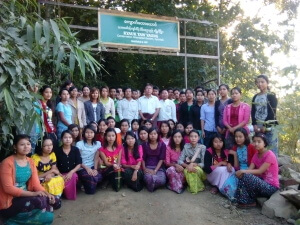The RCA’s conservation work began on a small scale: with the gradual reforestation of the land that would become the Kyauk Taw Yaung Conservation Garden. In 1987, Dr. Mg Mg Kyi purchased a 5 acre parcel located on the outskirts of Kyeintali, straddling the dividing line between the region’s two major land types. To the west the hilly plot overlooks the intensely cultivated coastal plain, bordered by mangroves and nipa plantations; to the east it faces the wild foothills of the Rakhine Range. Reshaped by decades of slash and burn agriculture, it required years of careful planting and management to convert it back into forest.
 Over the last three decades, the forest garden has grown and changed, while serving as an inspiration and basecamp for the RCA’s conservation activities. Today, thanks to decades of negotiations with local landowners, it occupies nearly 50 acres stretching back towards the hills, and provides a safe haven for rare local trees and flowers. A series of looping trails lead visitors past an incredible variety of native plants, from orchids to jungle creepers. In the wet season the garden is a riot of green; in the dry season it also turns orange and brown, and some of the trees lose their leaves. You can learn about medicinal plants. Wildlife has returned to the area as well with many animals using it as a safe feeding ground. Wild cats, monkeys, bears, barking deer, forest turtles, pangolins and many other species call the garden home.
Over the last three decades, the forest garden has grown and changed, while serving as an inspiration and basecamp for the RCA’s conservation activities. Today, thanks to decades of negotiations with local landowners, it occupies nearly 50 acres stretching back towards the hills, and provides a safe haven for rare local trees and flowers. A series of looping trails lead visitors past an incredible variety of native plants, from orchids to jungle creepers. In the wet season the garden is a riot of green; in the dry season it also turns orange and brown, and some of the trees lose their leaves. You can learn about medicinal plants. Wildlife has returned to the area as well with many animals using it as a safe feeding ground. Wild cats, monkeys, bears, barking deer, forest turtles, pangolins and many other species call the garden home.
Beyond its role in conserving Rakhine flora, the garden is connected to the surrounding area in a couple of ways. As an island of upland forest habitat in an area of shifting cultivation, it gives animals—especially birds—a stopping place between the Rakhine hills and protected areas on the coast. Kyauk Taw Yaung also acts as a testing ground for local water management strategies: a stream running through the land has been dammed to provide a reservoir, and pumped up the hill in readiness to share with Kyeintali in the dry season. Finally, since the construction of a new environmental education centre in 2012, the garden acts as a hub for local conservation training and community consultations.